
Myrtaceae, the myrtle family, is a family of dicotyledonous plants placed within the order Myrtales. Myrtle, pōhutukawa, bay rum tree, clove, guava, acca (feijoa), allspice, and eucalyptus are some notable members of this group. All species are woody, contain essential oils, and have flower parts in multiples of four or five. The leaves are evergreen, alternate to mostly opposite, simple, and usually entire. The flowers have a base number of five petals, though in several genera, the petals are minute or absent. The stamens are usually very conspicuous, brightly coloured, and numerous.
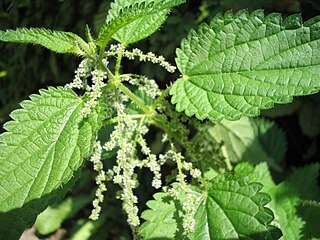
The Urticaceae are a family, the nettle family, of flowering plants. The family name comes from the genus Urtica. The Urticaceae include a number of well-known and useful plants, including nettles in the genus Urtica, ramie, māmaki, and ajlai.

Santalum is a genus of woody flowering plants in the Santalaceae family, the best known and commercially valuable of which is the Indian sandalwood tree, S. album. Members of the genus are trees or shrubs. Most are root parasites which photosynthesize their own food, but tap the roots of other species for water and inorganic nutrients. Several species, most notably S. album, produce highly aromatic wood, used for scents and perfumes and for herbal medicine. About 25 known species range across the Indomalayan, Australasian, and Oceanian realms, from India through Malesia to the Pacific Islands, as far as Hawaiʻi and the Juan Fernández Islands off the coast of South America.
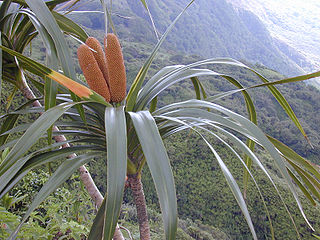
Freycinetia is one of the five extant genera in the flowering plant family Pandanaceae. The genus comprises approximately 180–200 species, most of them climbers.

Waitzia is a genus of Australian plants in the tribe Gnaphalieae within the family Asteraceae. The genus is native to Australia, where it grows in Western Australia, the Northern Territory, New South Wales, Victoria and South Australia.
- Waitzia acuminataSteetz - orange immortelle
- Waitzia corymbosaJ.C.Wendl.
- Waitzia nitida(Lindl.) Paul G.Wilson - golden waitzia
- Waitzia podolepis(Gaudich.) Benth.
- Waitzia suaveolens(Benth.) Druce - fragrant waitzia

The Joinvilleaceae are a family of flowering plants with a single genus including four species. The APG II system, of 2003 assigns it to the order Poales in the clade commelinids in the monocots. The family consists of one genus with four currently accepted species, distributed from the Malay Peninsula to the Caroline Islands and high islands in the Pacific Ocean. It is evolutionarily significant as a relictual group closely related to grasses. They closely resemble large grass plants, in both general appearance and microanatomy, but possess fleshy fruits.
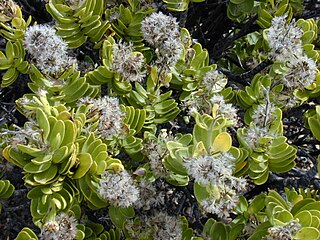
Dubautia or na'ena'e is a genus of flowering plant in the family Asteraceae. The genus was named after Joseph Eugène DuBaut (1796–1832), an officer in the French Navy who participated in Freycinet's expedition.

Eremaea is a genus of woody shrubs and small trees in the family Myrtaceae and is endemic to the south-west of Western Australia. Little study of the genus as a whole had been undertaken until Roger Hnatiuk researched Eremaea and published a paper in 1993, A revision of the genus Eremaea (Myrtaceae) in Nuytsia. The first species to be described was Eremaea pauciflora in 1837 and by 1964, the number of species known had increased to 12. Hnatiuk recognised 16 species, 5 subspecies and a number of varieties.

Ptilotus R.Br. is a genus of approximately 120 species of annual and perennial herbs and shrubs in the family Amaranthaceae. All species are native to mainland Australia, although one species, Ptilotus spathulatus (R.Br.) Poir., also occurs in Tasmania and another, Ptilotus conicus R.Br., in Malesia on the islands of Flores and Timor. Most of the diversity is in Western Australia, particularly in the Pilbara. Common names for species in this genus include mulla mulla, foxtails, pussy tails and lamb's tails. The genus was first formally described by botanist Robert Brown in Prodromus Florae Novae Hollandiae in 1810. In family-level phylogenetic studies, Ptilotus has been placed within a clade informally known as the 'aervoids'. It has been resolved as monophyletic and is closely related to Aerva Forssk. An interactive key to the species of Ptilotus is available at KeyBase.

Adriana is a genus of shrubs in the family Euphorbiaceae, first described as a genus in 1825. The entire genus is endemic to Australia.
- Adriana quadripartita(Labill.) Mull.Arg. - South Australia, Victoria, southern Western Australia
- Adriana tomentosaGaudich.- All mainland states
- Adriana urticoides(A.Cunn.) Guymer ex P.I.Forst. - Northern Territory plus all states except Tasmania
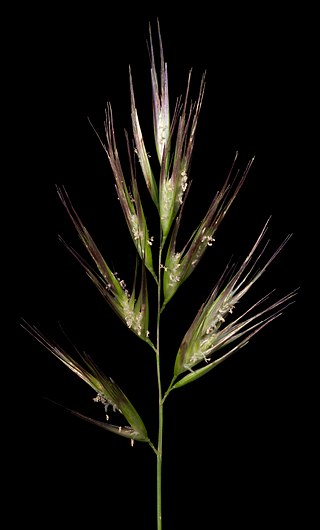
Rytidosperma caespitosum, known by various common names including common wallaby-grass, ringed wallaby-grass, and white-top, is a species of grass native to southern parts of Australia.
Austrostipa crinita is a species of grass that grows in coastal parts of midwest Western Australia.

Labichea is a genus of flowering plants in the family Fabaceae. It includes 16 species of shrubs native to northern Australia – Queensland, the Northern Territory, and Western Australia. Typical habitats are tropical and seasonally-dry, and include rocky sandstone ravines, coastal sand dunes, desert, and semi-arid woodland and dry scrub, generally on granite or sandstone substrates. It belongs to the subfamily Dialioideae.
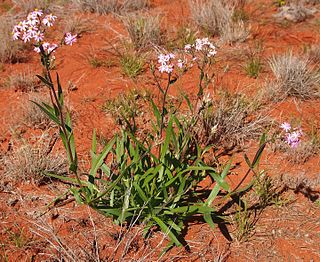
Schoenia is a genus of Australian plants in the tribe Gnaphalieae within the family Asteraceae.

Joinvillea is a flowering plants genus in the family Joinvilleaceae. The family consists of one genus with species distributed from the Malay Peninsula to the Caroline Islands and high islands in the Pacific Ocean. It is evolutionarily significant as a relictual group that is a close relative of grasses. They closely resemble large grass plants, in both general appearance and microanatomy, but possess fleshy fruits.

Machaerina (twigrush) is a genus of flowering plants in the sedge family. Its species occur in tropical America, the West Indies, Malesia, Australia and the Pacific region. The name comes from the Greek machaira, alluding to the shape of the leaves in the type species – Machaerina restioides.
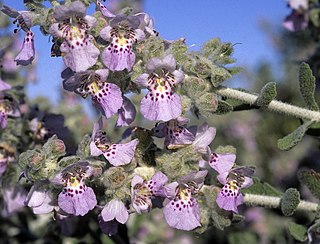
Quoya is a genus of flowering plants in family Lamiaceae and is endemic to Western Australia. Plants in this genus are shrubs with five petals joined to form a tube-shaped flower with four stamens of unequal lengths.

Ptilotus obovatus(Gaudich.) F.Muell. is a shrub in the genus Ptilotus R.Br. that occurs in throughout arid Australia. It is commonly known as cotton bush.
Lamarchea sulcata is a member of the family Myrtaceae endemic to Western Australia and the Northern Territory.

Morelotia is a genus of flowering plants belonging to the family Cyperaceae. It contains six species of sedges native to New Zealand, the Hawaiian Islands, Tubuai Islands, and Western Australia.
















